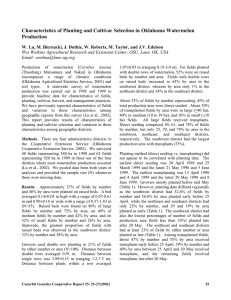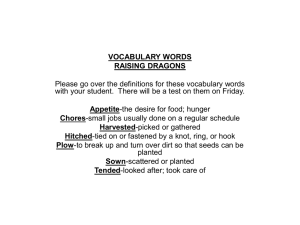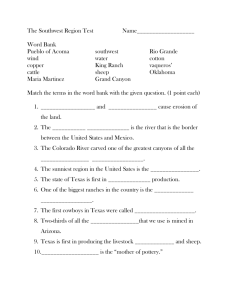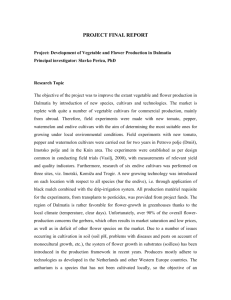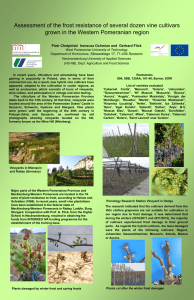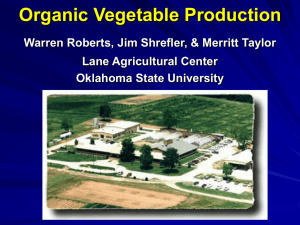Characteristics of Planting and Cultivar Selection in Oklahoma
advertisement
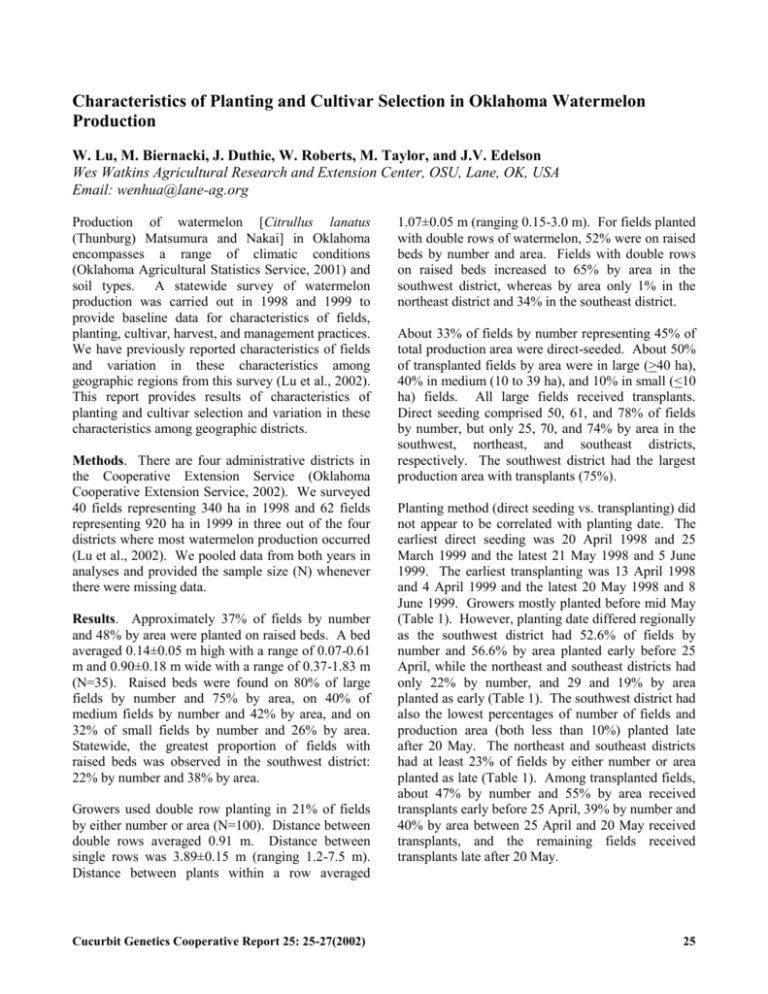
Characteristics of Planting and Cultivar Selection in Oklahoma Watermelon Production W. Lu, M. Biernacki, J. Duthie, W. Roberts, M. Taylor, and J.V. Edelson Wes Watkins Agricultural Research and Extension Center, OSU, Lane, OK, USA Email: wenhua@lane-ag.org Production of watermelon [Citrullus lanatus (Thunburg) Matsumura and Nakai] in Oklahoma encompasses a range of climatic conditions (Oklahoma Agricultural Statistics Service, 2001) and soil types. A statewide survey of watermelon production was carried out in 1998 and 1999 to provide baseline data for characteristics of fields, planting, cultivar, harvest, and management practices. We have previously reported characteristics of fields and variation in these characteristics among geographic regions from this survey (Lu et al., 2002). This report provides results of characteristics of planting and cultivar selection and variation in these characteristics among geographic districts. Methods. There are four administrative districts in the Cooperative Extension Service (Oklahoma Cooperative Extension Service, 2002). We surveyed 40 fields representing 340 ha in 1998 and 62 fields representing 920 ha in 1999 in three out of the four districts where most watermelon production occurred (Lu et al., 2002). We pooled data from both years in analyses and provided the sample size (N) whenever there were missing data. Results. Approximately 37% of fields by number and 48% by area were planted on raised beds. A bed averaged 0.14±0.05 m high with a range of 0.07-0.61 m and 0.90±0.18 m wide with a range of 0.37-1.83 m (N=35). Raised beds were found on 80% of large fields by number and 75% by area, on 40% of medium fields by number and 42% by area, and on 32% of small fields by number and 26% by area. Statewide, the greatest proportion of fields with raised beds was observed in the southwest district: 22% by number and 38% by area. Growers used double row planting in 21% of fields by either number or area (N=100). Distance between double rows averaged 0.91 m. Distance between single rows was 3.89±0.15 m (ranging 1.2-7.5 m). Distance between plants within a row averaged Cucurbit Genetics Cooperative Report 25: 25-27(2002) 1.07±0.05 m (ranging 0.15-3.0 m). For fields planted with double rows of watermelon, 52% were on raised beds by number and area. Fields with double rows on raised beds increased to 65% by area in the southwest district, whereas by area only 1% in the northeast district and 34% in the southeast district. About 33% of fields by number representing 45% of total production area were direct-seeded. About 50% of transplanted fields by area were in large (>40 ha), 40% in medium (10 to 39 ha), and 10% in small (<10 ha) fields. All large fields received transplants. Direct seeding comprised 50, 61, and 78% of fields by number, but only 25, 70, and 74% by area in the southwest, northeast, and southeast districts, respectively. The southwest district had the largest production area with transplants (75%). Planting method (direct seeding vs. transplanting) did not appear to be correlated with planting date. The earliest direct seeding was 20 April 1998 and 25 March 1999 and the latest 21 May 1998 and 5 June 1999. The earliest transplanting was 13 April 1998 and 4 April 1999 and the latest 20 May 1998 and 8 June 1999. Growers mostly planted before mid May (Table 1). However, planting date differed regionally as the southwest district had 52.6% of fields by number and 56.6% by area planted early before 25 April, while the northeast and southeast districts had only 22% by number, and 29 and 19% by area planted as early (Table 1). The southwest district had also the lowest percentages of number of fields and production area (both less than 10%) planted late after 20 May. The northeast and southeast districts had at least 23% of fields by either number or area planted as late (Table 1). Among transplanted fields, about 47% by number and 55% by area received transplants early before 25 April, 39% by number and 40% by area between 25 April and 20 May received transplants, and the remaining fields received transplants late after 20 May. 25 Large fields had higher proportions of early planting than small and medium fields. By number and area respectively, 26 and 30% of small, 40 and 38% of medium, and 60% of large fields were planted early before 25 April; 49 and 42% of small, 45 and 47% of medium, and 40% of large fields were planted between 25 April and 20 May; and 25 and 28% of small, 15% of medium, and 0% of large fields were planted late after 20 May. Growers used 36 cultivars during the two year survey. 'Allsweet' and 'Black Diamond' were the most frequently used among 19 diploid inbred (openpollinated) cultivars (14 and 13% by number, 13 and 8% by area, respectively). 'Sangria' and 'Royal Sweet' were the most frequently used among 12 diploid hybrid cultivars (12 and 7% by number, 7 and 9% by area, respectively). Triploid hybrid (seedless) cultivars planted included 'Abbott Cobb 5244', 'Tri-X 313', 'Sugar Time', 'Summer Sweet', and 'Fandango'. Triploid hybrids were in 13% of fields by number but 36% by area; diploid hybrids were in 47% of fields by number and 34% by area; and open-pollinated cultivars were in the remaining 40% of fields by number and 30% by area (Table 2). Triploid cultivars were observed only in the southwest district (Table 2). Among large fields, 80% by number and 87% by area were planted with triploid cultivars. Among medium fields 18% by number and 21% by area were planted with triploid cultivars. Among small fields 4% by either number or area were planted with triploid cultivars. Fields with raised bed receive triploids 77% by number and 75% by area. Fields of double row configuration received the 3 cultivar genotypes in about equal area. Fields received any of the 3 genotypes mostly before mid May. Growers often used more than one watermelon cultivar in a field. Triploid cultivars required use of a diploid pollenizer. In addition, a mix of more than one cultivar genotype was common. Altogether, multiple cultivars were planted in 73% of fields by number and 80% by area (N=66). Among fields with multiple cultivars, 50% by either number or area Cucurbit Genetics Cooperative Report 25: 25-27(2002) were planted with 2 cultivars, 29% by number and 39% by area planted with 3 cultivars, and the remaining 21% by number and 11% by area with 4 to 7 cultivars. Fields had 16, 17, and 32% by number, 8, 12, and 52% by area in the southwest, northeast, and southeast districts planted with multiple cultivars, respectively. Among 36 transplanted fields, 36% by number and 66% by area received triploids; 58% by number and 31% by area received diploid hybrids. The remaining small proportion received open-pollinated cultivars. Among 66 direct-seeded fields, none received triploids; 59% by number and 62% by area received diploid hybrids; and 41% by number and 38% by area received open-pollinated cultivars. Conclusions. Most fields were direct-seeded before mid May in single rows without raised beds with multiple cultivars in Oklahoma. Fields with raised beds or transplants were primarily planted to triploid cultivars. Raised bedding, double row planting, and planting date did not correlate with cultivar. Growers in the southeast district most often planted multiple cultivars. Growers in the southwest district most often used raised beds, planted early, used transplants, and grew triploid cultivars. Literature Cited 1. Lu, W., M. Biernacki, J. Duthie, W. Roberts, M. Taylor, and J. Edelson. 2002. Characteristics of watermelon (Citrullus lanatus) fields and production in Oklahoma. In Proceedings of Cucurbits 2002 Conference, in press. 2. Oklahoma Agricultural Statistics Service. 2001. Oklahoma agricultural statistics 2000. Oklahoma Department of Agriculture, Oklahoma City, OK. 3. Oklahoma Cooperative Extension Service. 2002. Administrative districts and area specialists. In 2002 Personnel Directory, pp 24-25. Oklahoma State Univ. 26 Table 1. Total number and total hectare of watermelon fields under different planting dates during an extensive statewide survey in 1998 and 1999 in Oklahoma, where dates were early before 25 April, medium from 25 April to 20 May, and late after 20 May Date District Total number of fields Total area of fields (ha) Early Medium Late Total Early Medium Late Total NE 4 9 5 18 36.42 59.09 29.14 124.65 SE 10 24 12 46 73.66 207.15 104.41 385.21 SW 20 15 3 38 424.53 290.57 34.40 749.50 Statewide 34 48 20 102 534.61 556.81 167.95 1259.37 Table 2. Total number and total hectare of watermelon fields with different cultivar genotypes during an extensive statewide survey in 1998 and 1999 in Oklahoma Total number of fields Genotype Open Diploid Triploid pollinated hybrid hybrid NE 7 11 SE 19 27 SW 15 10 Statewide 41 48 District Total area of fields (ha) Open Diploid Triploid pollinated hybrid hybrid 18 58.28 66.37 124.65 46 149.68 235.54 385.21 13 38 162.69 129.91 456.91 749.50 13 102 370.64 431.81 456.91 1259.37 Cucurbit Genetics Cooperative Report 25: 25-27(2002) Total Total 27
